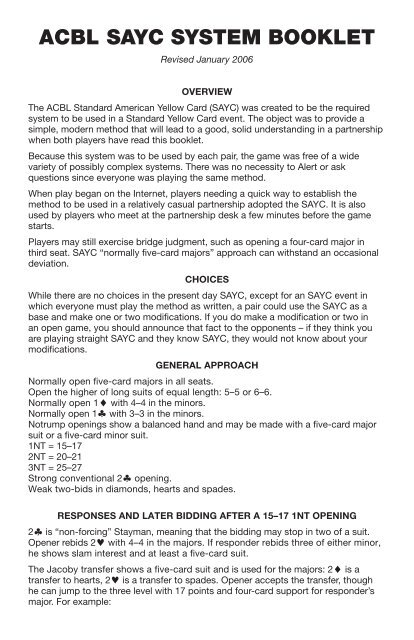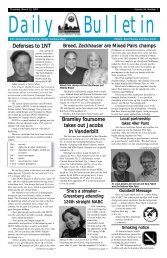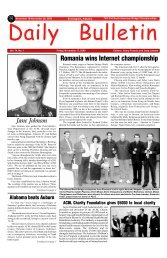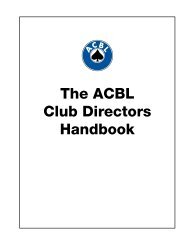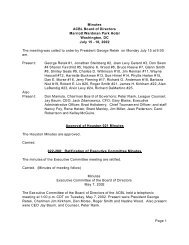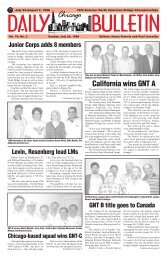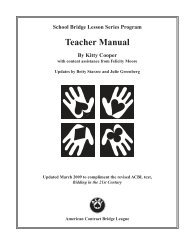ACBL SAYC SYSTEM BOOKLET - American Contract Bridge League
ACBL SAYC SYSTEM BOOKLET - American Contract Bridge League
ACBL SAYC SYSTEM BOOKLET - American Contract Bridge League
You also want an ePaper? Increase the reach of your titles
YUMPU automatically turns print PDFs into web optimized ePapers that Google loves.
<strong>ACBL</strong> <strong>SAYC</strong> <strong>SYSTEM</strong> <strong>BOOKLET</strong><br />
Revised January 2006<br />
OVERVIEW<br />
The <strong>ACBL</strong> Standard <strong>American</strong> Yellow Card (<strong>SAYC</strong>) was created to be the required<br />
system to be used in a Standard Yellow Card event. The object was to provide a<br />
simple, modern method that will lead to a good, solid understanding in a partnership<br />
when both players have read this booklet.<br />
Because this system was to be used by each pair, the game was free of a wide<br />
variety of possibly complex systems. There was no necessity to Alert or ask<br />
questions since everyone was playing the same method.<br />
When play began on the Internet, players needing a quick way to establish the<br />
method to be used in a relatively casual partnership adopted the <strong>SAYC</strong>. It is also<br />
used by players who meet at the partnership desk a few minutes before the game<br />
starts.<br />
Players may still exercise bridge judgment, such as opening a four-card major in<br />
third seat. <strong>SAYC</strong> “normally five-card majors” approach can withstand an occasional<br />
deviation.<br />
CHOICES<br />
While there are no choices in the present day <strong>SAYC</strong>, except for an <strong>SAYC</strong> event in<br />
which everyone must play the method as written, a pair could use the <strong>SAYC</strong> as a<br />
base and make one or two modifications. If you do make a modification or two in<br />
an open game, you should announce that fact to the opponents – if they think you<br />
are playing straight <strong>SAYC</strong> and they know <strong>SAYC</strong>, they would not know about your<br />
modifications.<br />
GENERAL APPROACH<br />
Normally open five-card majors in all seats.<br />
Open the higher of long suits of equal length: 5–5 or 6–6.<br />
Normally open 1� with 4–4 in the minors.<br />
Normally open 1� with 3–3 in the minors.<br />
Notrump openings show a balanced hand and may be made with a five-card major<br />
suit or a five-card minor suit.<br />
1NT = 15–17<br />
2NT = 20–21<br />
3NT = 25–27<br />
Strong conventional 2� opening.<br />
Weak two-bids in diamonds, hearts and spades.<br />
RESPONSES AND LATER BIDDING AFTER A 15–17 1NT OPENING<br />
2� is “non-forcing” Stayman, meaning that the bidding may stop in two of a suit.<br />
Opener rebids 2� with 4–4 in the majors. If responder rebids three of either minor,<br />
he shows slam interest and at least a five-card suit.<br />
The Jacoby transfer shows a five-card suit and is used for the majors: 2� is a<br />
transfer to hearts, 2� is a transfer to spades. Opener accepts the transfer, though<br />
he can jump to the three level with 17 points and four-card support for responder’s<br />
major. For example:
1NT — 2�<br />
2� = normal acceptance of the transfer.<br />
3� = 17 points and four-card heart support.<br />
If, after the transfer is accepted, responder bids a new suit, that is natural and<br />
game forcing. Possible calls after the accepted transfer are:<br />
1NT — 2�<br />
2� — Pass = content to play 2�.<br />
— 2NT, 3� = invitational. Over 2NT opener may pass or bid 3�<br />
with a minimum hand; bid 3NT or 4� with a maximum.<br />
— 3�, 3�, 3� = natural and game forcing.<br />
— 3NT = giving opener a choice between 3NT and 4�.<br />
— 4� = placing the contract, with a six-card or longer suit.<br />
A 2� response requires the 1NT bidder to rebid 3�, which may be passed with a<br />
club bust, or responder may rebid 3� with a diamond bust. Example:<br />
1NT — 2�<br />
3� — Pass = club bust<br />
— 3� = diamond bust (notrump opener passes).<br />
Other responses to 1NT:<br />
1NT — 3�, 3� = a six-card or longer suit and invitational to 3NT.<br />
— 3�, 3� = at least a six-card suit and slam interest<br />
(otherwise, responder uses a transfer bid).<br />
— 4� = Gerber, asking for aces. 4� IS GERBER OVER ANY 1NT OR 2NT<br />
BY PARTNER, INCLUDING A REBID OF 1NT OR 2NT. Responses<br />
show the number of aces, by steps, just as over a Blackwood<br />
4NT. 5� is used to ask for kings.<br />
Ace Asking King Asking<br />
1NT — 4� 1NT — 4�<br />
4� = 0 or 4 aces 4x — 5�<br />
4� = 1 ace 5� = 0 or 4 kings<br />
4� = 2 aces 5� = 1 king<br />
4NT = 3 aces 5� = 2 kings<br />
5NT = 3 kings<br />
If the player using Gerber makes any bid other than 5�, that is to play<br />
(including 4NT). Asking for kings guarantees that the partnership holds all the aces.<br />
A direct raise of 1NT to 4NT is natural and invites 6NT. 4NT is slam invitational only<br />
because 4� is available as Gerber (to ask about aces).<br />
INTERFERENCE AFTER A 1NT OPENING BID<br />
If an opponent doubles, all conventional responses are “on.” For example:<br />
1NT — (Double) — 2� = Stayman<br />
1NT — (Double) — 2� = transfer to hearts<br />
If an opponent bids over your 1NT opener, conventional responses like Stayman<br />
and transfers are “off.” Bids are natural except for a cuebid, which may be used with<br />
game forcing strength as a substitute for Stayman.<br />
If the opponents intervene over a conventional response, bids carry the same<br />
meaning as if there were no intervention. A bid says, “I’m bidding voluntarily, so I<br />
have a real fit with you.”<br />
1NT — (Pass) — 2� — (Double)<br />
2� = Real fit for hearts — pass with only two hearts<br />
2
RESPONSES TO A 2NT OR A 3NT OPENING<br />
Stayman and Jacoby transfers for the majors are used.<br />
2NT — 3� = Stayman.<br />
— 3�, 3� = Jacoby transfers to hearts and spades, respectively.<br />
— 4� = Gerber (ace asking).<br />
— 4NT = Invites a slam in notrump.<br />
3NT — 4� = Stayman.<br />
— 4�, 4� = Jacoby transfers to hearts and spades, respectively.<br />
RESPONSES AND LATER BIDDING AFTER A 1� OR A 1� OPENING<br />
1� and 1� openings show a five-card or longer suit. Responses:<br />
1 � — 1� = at least four spades, 6 or more points. Tends to deny a heart fit.<br />
— 1NT = 6–9 points, denies four spades or three hearts. NOT forcing.<br />
— 2�, 2� = 10 points or more, promises at least four of the suit.<br />
— 2� = three-card or longer heart support; 6–10 dummy points.<br />
— 2NT = Game-forcing raise (Jacoby 2NT), 13+ dummy points. Asks<br />
opener to show a short suit to help responder evaluate slam prospects.<br />
(see * below)<br />
— 2�, 3�, 3� = strong jump shifts. Invites a slam.<br />
— 3� = limit raise (10–11 dummy points with three or more hearts).<br />
— 3NT = 15–17 HCP, balanced hand with two-card support for partner.<br />
— 4� = usually five+ hearts, a singleton or void, and fewer than 10 HCP.<br />
Opener’s rebids are natural and standard.<br />
Rebids with a minimum hand (13–15 points):<br />
Rebidding notrump at the lowest available level;<br />
Raising responder’s suit at the lowest level (may have good three-card support);<br />
Rebidding a new suit at the one level or rebidding a new suit at the two level<br />
that is lower ranking than the opening suit (not reversing);<br />
Rebidding opener’s suit at the lowest level.<br />
Rebids with a medium hand (16–18 points):<br />
Jump raise of responder’s suit or jump rebid of opener’s suit;<br />
Reverse in a new suit, i.e., bid a new suit at the two level which is higher ranking<br />
than the opening suit;<br />
Non-reverse bid in a new suit (this has the wide range of 13–18 points).<br />
With a maximum hand (19–21 or 22 points) opener must make a very strong rebid:<br />
Jump in notrump;<br />
Double jump raise of responder’s suit or double jump rebid of opener’s suit;<br />
Jump shift in a new suit.<br />
* If responder jumps to 2NT over a 1� or 1� opening, that is Jacoby 2NT, asking<br />
opener to show a singleton or void. If opener has no short suit, he shows his<br />
hand strength;<br />
1� — 2NT<br />
3�, 3�, 3� = singleton or void in that suit. Other bids deny a short suit.<br />
4� = minimum hand.<br />
3NT = medium hand (15–17).<br />
3� = maximum hand (18+)<br />
4�, 4� = 2nd suit<br />
Responder follows up by attempting to sign off in game, bidding 4NT Blackwood,<br />
or cuebidding if still interested in trying to cooperate with opener in making the<br />
slam decision.<br />
3
SUBSEQUENT BIDDING BY RESPONDER<br />
If responder has bid a suit at the one level, he next determines whether he wishes<br />
to sign off in a partscore, invite game, sign off in game, or force to game and get<br />
more information about opener’s hand.<br />
Bids available for a sign-off in partscore: Pass, 1NT, 2 of a previously bid suit.<br />
1� — 1�<br />
2� — Pass, 2�, 2� = 6–9 points, sign-off in partscore.<br />
Bids available for inviting game: 2NT, 3 of a previously bid suit:<br />
1� — 1�<br />
2� — 2NT, 3�, 3�, 3� = 10–11 points, inviting game.<br />
After opener rebids in a suit, a new suit by responder is forcing. If the new suit is the<br />
fourth suit, the bid may be artificial/conventional.<br />
1� — 1�<br />
2� — 2� = one-round force, could be conventional.<br />
However, after a 1NT rebid by opener, bids of a new suit at the next higher level are<br />
non-forcing.<br />
1� — 1�<br />
1NT — 2�, 2� = non-forcing. Responder must jump shift to 3� or 3�<br />
to force game.<br />
Second-round forcing bids following a 1NT rebid by opener: a reverse or jump shift<br />
into a new suit is a game force.<br />
1� — 1�<br />
1NT — 2� or 3� = game force.<br />
Bids available for signing off in game.<br />
3NT, 4�, 4�, 5�, 5�.<br />
If responder initially bids a new suit at the two level, the same rules apply EXCEPT<br />
that a subsequent jump raise of opener’s first suit to the THREE LEVEL is game<br />
forcing — responder should make a limit raise directly over the opening with 10–11<br />
points and at least three-card support:<br />
1� — 2�<br />
2� — 2NT, 3�, 3� = invitation to game (10–11 points).<br />
— 2� = preference, not forcing. Responder has 11–12 points and a<br />
doubleton spade.<br />
— 3� = game force, could be conventional.<br />
— 3� = game force.<br />
NOTE: Responder promises to bid again if he responded with a new suit at the two<br />
level unless opener’s rebid is at the game level. This applies when responder is an<br />
unpassed hand.<br />
1� — 2�<br />
2� = forcing one round. Responder can limit his hand by bidding 2�, 2NT,<br />
3�, or 3� at this point. He should not pass, since opener could have 18<br />
points (just short of a jump shift rebid).<br />
4
RESPONSES TO A 1� OR A 1� OPENING<br />
A 1� opener suggests a four-card or longer suit, since 1� is preferred on hands<br />
where a three-card minor suit must be opened. The exception is a hand with 4–4–3–2<br />
shape: four spades, four hearts, three diamonds, and two clubs, which is opened 1�.<br />
Responses and later bidding generally follow the ideas set down in the previous<br />
section. Bidding at the one level is up-the-line in principle. Responder needs more<br />
support to raise (four to raise 1�; five to raise 1�, though one fewer will do in a<br />
pinch in a competitive sequence). Responses of 2NT and 3NT are standard:<br />
1� — 2NT = 13–15, game forcing<br />
— 3NT = 16–18<br />
There is no forcing minor-suit raise.<br />
A 2� OPENING, RESPONSES, AND LATER BIDDING<br />
A 2� opening shows at least 22+ points, or the playing equivalent. Responses:<br />
2� — 2� = conventional, could be “waiting” with a good hand not suited to a<br />
positive response.<br />
— 2�, 2�, 3�, 3� = natural and game forcing. At least a five-card suit<br />
and 8 points.<br />
— 2NT = a balanced 8 HCP.<br />
If opener rebids 2NT after a 2� response (showing 22–24 points), the same<br />
responses are used as over a 2NT opening:<br />
2� — 2�<br />
2NT — 3� = Stayman.<br />
— 3�, 3� = Jacoby transfers to hearts and spades, respectively.<br />
— 4� = Gerber.<br />
— 4NT = inviting a slam in notrump.<br />
If opener rebids a suit over a 2� response, the bidding is forcing to 3 of opener’s<br />
major or 4 of opener’s minor.<br />
2� — 2�<br />
2� — 2�<br />
3� = not forcing.<br />
SEQUENCE AFTER A WEAK TWO-BID OF 2�, 2� OR 2�<br />
A weak two-bid shows a six-card suit of reasonable quality and 5–11 HCP. On rare<br />
occasions it may be a very good five-card suit. It is possible to open a weak two with a<br />
poor seven-card suit (not good enough to open with at the three level). Responses:<br />
A 2NT response is forcing, showing game interest. (This applies also if the<br />
opponents intervene with a double or a bid.) Opener rebids his suit with a<br />
minimum weak two (5–8 points). With a maximum hand opener bids another<br />
suit to show a “feature” (ace or king in that suit); lacking a feature, he raises to<br />
3NT and lets responder place the contract.<br />
Any raise of opener’s suit is to play and could be preemptive (weak). A 3NT<br />
response is also to play.<br />
“RONF” on the card means “Raise Only Non-Force.” A new-suit response is<br />
forcing one round and shows at least a five-card suit. Opener should raise a major<br />
suit response with a three-card fit, or perhaps with a doubleton honor.<br />
With no fit for responder’s suit, opener rebids:<br />
With a minimum weak two-bid (5–8 points), rebid the suit at the lowest level.<br />
With a maximum weak two-bid, name a new suit or bid notrump.<br />
5
OPENING PREEMPTS<br />
Opposite an unpassed partner, an opening 3 or 4-level call in a suit tends toward<br />
sound at equal or unfavorable vulnerability. Vulnerable against not, you should be<br />
within two tricks of your bid (i.e. with likely distribution of the remaining cards in your<br />
suit). When the vulnerability is equal, you should be within three tricks of your bid. At<br />
favorable vulnerability, the preempt tends to be lighter, so you should be within four<br />
tricks of your bid.<br />
SLAM BIDDING<br />
Blackwood 4NT is used to ask for aces. Responses show the number of aces by<br />
steps. 5NT is then used to ask for kings; 5NT guarantees that the partnership holds<br />
all four aces.<br />
— — —<br />
— — — — — 4NT<br />
— — 4NT 5x — 5NT<br />
5� = 0 or 4 aces 6� = 0 or 4 kings<br />
5� = 1 ace 6� = 1 king<br />
5� = 2 aces 6� = 2 kings<br />
5� = 3 aces 6� = 3 kings<br />
A jump to 5NT (and some 5NT bids when the auction is at the five level) is “Grand<br />
Slam Force,” asking partner to bid a grand slam with two of the three top honors in<br />
the agreed suit;<br />
5NT — 6 of the agreed suit = fewer than two top honors (A, K or Q).<br />
— 7 of the agreed suit = two of the three top honors.<br />
DEFENSIVE BIDDING<br />
Overcalls show 8–16 points (double and bid the long suit with a stronger hand).<br />
The only forcing response is a cuebid of opener’s suit, asking the overcaller about<br />
the quality of his overcall:<br />
(1�) — 1� — (Pass) — 2�<br />
(Pass) — 2� = minimum overcall.<br />
— other = extra strength (11 or 12 points minimum).<br />
A 1NT overcall shows 15–18 points and a balanced hand (preferably a stopper in<br />
opener’s suit). No conventional responses are used by the responder to the 1NT<br />
overcall except 2�, which is Stayman.<br />
A jump overcall of 2NT shows at least 5–5 in the lowest two unbid suits.<br />
Jump overcalls are preemptive, showing the same value as an opening bid at the<br />
same level:<br />
(1�) — 2� = a hand that would open a weak two-bid in spades.<br />
— 3� = a hand that would open 3�.<br />
A cuebid overcall when the opponents have bid two suits is natural in either suit.<br />
A cuebid overcall when the opponents have bid only one suit is a Michaels cuebid,<br />
showing a 5–5 two-suiter (or more distributional). If the opening is in a minor suit,<br />
the cuebid shows the majors; if the opening is in a major, the cuebid shows the<br />
other major and an unspecified minor.<br />
(1�) — 2� = at least 5–5 in the majors, 8 points or more.<br />
(1�) — 2� = at least 5–5 in hearts and a minor; 10 points or more.<br />
6
Responder may bid 2NT over a major suit cuebid to ask for partner’s minor.<br />
(1�) — 2� — (Pass) — 2NT (asks for the minor).<br />
(Pass) — 3� = club suit.<br />
— 3� = diamond suit.<br />
A reopening bid means much the same as a direct seat bid, though it can be lighter<br />
at the minimum end. A reopening 1NT after an opponent has opened shows 10–15<br />
points. This is a wide range, but there will not usually be a game on for you.<br />
A double is for takeout over an opening partscore bid (4� or lower); penalty over<br />
opening game bids (4� or higher). A below-game jump response to a takeout<br />
double is invitational. To force, responder cuebids opener’s suit.<br />
Versus an opening preempt, an overcall in a suit or notrump is natural; a cuebid is<br />
Michaels.<br />
COMPETITIVE BIDDING<br />
There is almost an endless variety of possible sequences, so it pays to have<br />
simple guidelines to prevent bidding misunderstandings.<br />
Bids mean the same things they meant without the intervening bid. Still, it is<br />
sometimes necessary to pick a bid that would normally have been a second choice<br />
without the overcall:<br />
1� — (Pass) — 1� — (2�)<br />
2� with �J 4 3 �A 8 7 5 �A Q J 4 �J 3 (rebid 1NT if RHO has passed)<br />
Cuebidding right-hand opponent’s suit shows values for game without clear<br />
direction for the moment. This is often used to show a game-forcing raise:<br />
1� — (2�) — 3� = game force; usually a raise.<br />
The negative double is used through 2�, promising four cards (at least) in an unbid<br />
major. Bidding a major at the two level or higher shows 11 or more points and a fivecard<br />
or longer suit.<br />
1� — (1�) — Double = 4–4 or better in the majors.<br />
1� — (1�) — Double = exactly four spades (1� promises five).<br />
1� — (1�) — Double = four hearts and 6+ points or five hearts<br />
and 5–10 points.<br />
If RHO makes a takeout double:<br />
1� — (Double) — 1�, 1� = forcing, point count not limited.<br />
— 2� = non-forcing (6–10 points, usually a six-card suit).<br />
— 2NT = limit raise (at least 10 points) or better.<br />
— Redouble = 10 points or more, but it is better to make a more<br />
descriptive bid of 1�, 1�, or 2NT with the appropriate hand.<br />
— 3� = preemptive, good trump support but fewer than 10 points.<br />
A responder’s jump shift after a double is to play:<br />
1� — (Double) — 2�, 2�, 3� = six-plus card suit, like a weak two-bid or<br />
preemptive three-bid.<br />
A redouble can have one of three meanings:<br />
To play if:<br />
Your side is at the four level or higher:<br />
4� — (Double) — Redouble = Penalty;<br />
7
The opponents double a conventional bid:<br />
1NT — (Pass) — 2� — (Double)<br />
Redouble = Penalty, good diamond suit;<br />
A good hand if their double is for takeout:<br />
1� — (Double) — Redouble = 10+ points;<br />
SOS, requesting a different suit, if your side is doubled for penalty in a trump suit<br />
at the three level or lower:<br />
1� — (Pass) — Pass — (Double)<br />
Pass — (Pass) — Redouble = SOS, responder can support at least two of the<br />
unbid suits.<br />
Unless otherwise noted elsewhere, any bid or double by an opponent cancels<br />
a convention intended for non-competitive sequences.<br />
Examples: 1� — 2� — 2NT = natural (12–14 HCP).<br />
2� — Double — 2� = natural and positive.<br />
If the opponents use a convention (such as Michaels or the unusual notrump), you<br />
can double to show at least 10 points, or you can cuebid one of their shown suits<br />
to force to game.<br />
1� — (2�) — 3� = game force.<br />
— Double = at least 10 points, probably balanced.<br />
DEFENSIVE LEADS AND SIGNALS<br />
Defensive signals when following suit or discarding are “high encourages, low<br />
discourages.” And “High-low is an even number, low-high is odd when count is<br />
given.”<br />
Leads are fourth best. From three low cards against a suit contract lead low; against<br />
a notrump contract lead high. From four cards or longer lead fourth best. The one<br />
systemic exception is leading from a suit of four or more cards without an honor. In<br />
this instance lead the second highest card.<br />
Leads are top of touching honors and top from an interior sequence. Against suits,<br />
the ace is led from A K x.<br />
NOTE: When playing the <strong>ACBL</strong> <strong>SAYC</strong>:<br />
You may add defenses to the opponents’ conventions (e.g., unusual vs. unusual, and<br />
Mathe over big club). Put these convention-defenses in the section “Defenses vs.<br />
Opp’s Conventions” on the left-hand side of the convention card.<br />
#170358 SP3 (bk)<br />
Printed in USA Rev. 1/06


